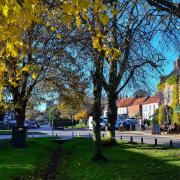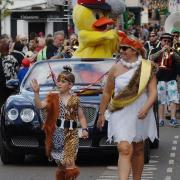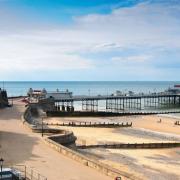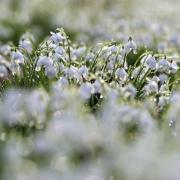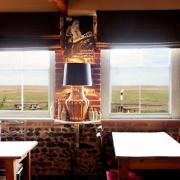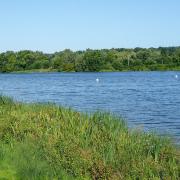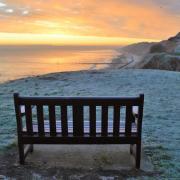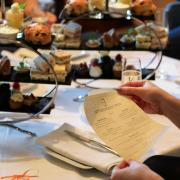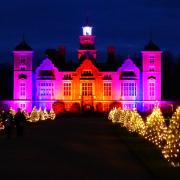Barely bigger than a village, Hingham has claims to national and international fame
Well-connected
Hingham has so many grand houses it was once known as Little London. Hingham Market Place boasts some particularly fine Georgian buildings. Some are even older behind fine facades, including the The White Hart Inn, with its impressive white hart statue standing guard above a columned porch. The town has long-standing royal connections too. More than 1,000 years ago it was the property of King Athelstan and from 1066 was owned by William the Conqueror.

Exodus
When some of the 17th century residents of Hingham, Norfolk, got fed up with what they saw as the godless ways of their country they simply created another Hingham more than 3,000 miles away across the Atlantic. So many left Hingham, Norfolk, for Hingham, USA, in the 1630s that residents who stayed in the original Hingham wrote to Parliament to complain that the town had been devastated by the exodus of ‘most of the able inhabitants.’ These included the rector Robert Peck and half his congregation, Edward Gilman, ancestor of one of the men who signed the US constitution and Samuel Lincoln, ancestor of President Abraham Lincoln.

Lincoln legacy
The most famous son of Hingham is Abraham Lincoln, 19th century president of the USA. Apprentice weaver Samuel Lincoln left England for New England more than 200 years before his great, great, great, great grandson Abraham became president, but his roots are remembered in Norfolk. The town hall in Norfolk’s Hingham is called Lincoln Hall and exactly 100 years ago a bust of the American president, who led the US through the civil war and abolished slavery, was unveiled in the parish church by the American ambassador.
Ancient and ship shape
The church in Hingham, Norfolk, was rebuilt 700 years ago. Over the pond in Hingham, Massachusetts, the church built 338 years ago is the oldest church in continuous use in the United States and the only surviving 17th-century Puritan meeting house in America. Known as the Old Ship Church because its huge hammer-beam roof makes it look like an upside-down ship, the carpenters would have learned their trade in Norfolk. Its christening bowl was probably brought from Norfolk’s Hingham, and the congregation’s first minister was the Rev Peter Hobart, also originally from the town. The current minister is one of his descendants.

What ho!
The family which boasts Jeeves and Wooster author PG Wodehouse within its titled ranks has Hingham links. The stained glass in the vast east window of the parish church (one of the largest east windows in the country) was a gift from the Wodehouse family, earls of nearby Kimberley. And Admiral’s House in the Market Place is named for Admiral Sir Philip Wodehouse, who lived there two centuries ago.
Trade today
Hingham is not just historic. Alongside all the usual shops of a thriving market town are a post office in a tearoom, the fascinating and ever-changing architectural salvage and antiques to be discovered at Mongers, which was also featured on TV’s Salvage Hunters; the Bond Street Shop where more than 40 artists and makers exhibit anything from cards to clothes and paintings to plants, and Hingham Antiques Fair, one of Norfolk’s oldest and largest antique fairs held on the last Sunday of each month. It also has tea shops popular with local cyclists and the White Hart Hotel, with its impressive stag.

Anyone for tennis?
in 2017, Hingham Tennis was named the Lawn Tennis Association’s national Club of the Year after volunteers raised £90,000 for new courts and a clubhouse and boosted membership to more than 230 in a town of just 1,000 homes.
Picture perfect
Ember Films was set up near Hingham by Emmy award-winning wildlife cameraman Jonathan Jones. Its film-makers have worked with broadcasters around the world including Disney, Netflix and the BBC. Jonathan worked with David Attenborough to bring wildlife from the Himalayas to the deserts into our living rooms in Planet Earth II and he and his talented colleagues have shot advertisements for multinationals including Pepsi and Jaguar, photographed international stars and worked on major films.

Ice lake
Sea Mere is a Hingham farm including a 20 acre circular lake formed by a retreating ice sheet 10,000 years ago. Now the lake and ancient woodland around it are a site of Special Scientific Interest.
Sea Mere gardens, laid out more than 120 years ago, are home to a national collection of gunnera plants (with one clump believed to be 100 years old.)
The gardens are occasionally open to visitors by appointment only and include an ornamental vegetable garden, winter garden, orchard, rose garden, wildflower meadows and five terraced lawns leading to the wetland garden and lake.

Double bubble
Hingham’s watermill is doubly unique in Norfolk. Instead of being fed by a river it was driven by springs, bubbling up from underground. And the building itself, now a home, is the only three storey building made entirely of clay lump (clay, straw, mud and dung formed into large blocks.)
Vanished
Hingham might be one of the smaller towns in Norfolk, but it has managed to hide a castle and an airfield. A 1610 map of the area shows a castle in Hingham and in the First World War the Royal Flying Corps flew from a grass airfield, but the government database of historic sites reports its exact location has been lost. Runways remain at nearby Deopham Green Airfield, used by American Flying Fortress aircraft during the Second World War.




